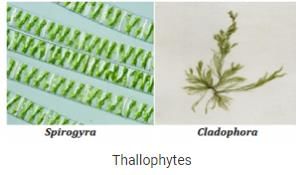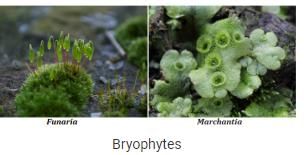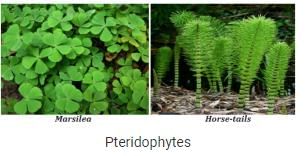Class 11 Exam > Class 11 Questions > What is the kingdom of plant kingdom. Related...
Start Learning for Free
What is the kingdom of plant kingdom.
Verified Answer
What is the kingdom of plant kingdom. Related: Bryophyta - Plant King...
Plant Kingdom – Plantae
Plantae is the plant kingdom which includes all plants on the earth. They are multicellular eukaryotes. Typically, they consist of a rigid structure that surrounds the cell membrane called the cell wall. Plants also have a green coloured pigment called chlorophyll that are quite important for photosynthesis. Hence, they have an autotrophic mode of nutrition. The plant kingdom is a vast group; therefore, the kingdom is further classified into subgroups. Level of classification is based on the following three criteria:
Plant body: whether the body has well-differentiated structures or not.
Vascular system: whether the plant has vascular system for transportation of substances or not
Seed formation: whether the plant bears flowers and seeds or not; if it does, then whether it is enclosed within fruits or not.
Considering all these factors, the plant kingdom has been divided into five subgroups. They are as follows:
Thallophyta
Bryophyta
Pteridophyta
Gymnosperms
Angiosperms
Thallophyta
All the plants that lack a well-differentiated body structure belong to the subgroup Thallophyta. Thallophytes are commonly known as algae. The majority of them are aquatic. Some examples are Spirogyra, Chara, Ulothrix, etc.

Bryophyta

Bryophytes have differentiated plant body like stem, leaf structures. But they lack a vascular system for the transportation of substances across the plant body. Bryophytes are found in both land and aquatic habitats, hence are known as amphibians of the plant kingdom. Mosses and Marchantia belong to this subgroup.
Pteridophyta
Pteridophytes have well-differentiated structures such as stem, root, leaves as well as a vascular system. Ferns, horsetails, Marsilea are some common examples of Pteridophytes.

 This question is part of UPSC exam. View all Class 11 courses
This question is part of UPSC exam. View all Class 11 courses
Most Upvoted Answer
What is the kingdom of plant kingdom. Related: Bryophyta - Plant King...
Kingdom Plantae
The kingdom Plantae, also known as the plant kingdom, is one of the five major kingdoms in the classification of living organisms. It consists of multicellular eukaryotic organisms that possess cell walls made of cellulose and carry out photosynthesis to obtain energy. Plants are essential for the Earth's ecosystem as they produce oxygen, provide food, and contribute to the overall balance of the environment.
Bryophyta: Introduction
Bryophyta, commonly known as mosses, is a division within the plant kingdom. It includes non-vascular plants that lack specialized tissues for conducting water and nutrients. Bryophytes are found in various habitats, including moist forests, tundra, and even on rocks. They play a vital role in maintaining soil quality and preventing erosion.
Characteristics of Bryophyta
- Lack of Vascular Tissues: Unlike higher plants, bryophytes lack specialized tissues for transporting water and nutrients. However, they can still absorb water and nutrients through their simple structures.
- Small Size: Bryophytes are generally small in size, ranging from a few millimeters to a few centimeters. They have a simple body structure consisting of a stem-like structure, leaf-like structures, and rhizoids for anchoring.
- Reproduction: Bryophytes exhibit alternation of generations, where the haploid gametophyte and diploid sporophyte generations alternate. The gametophyte generation produces reproductive structures called gametangia, which produce gametes. Fertilization occurs when sperm from the male gametangium reaches the female gametangium, resulting in the formation of a diploid zygote.
- Water Dependence: Bryophytes require water for reproduction because the sperm cells need a water medium to reach the female reproductive structures. They also depend on water for the uptake of nutrients and for maintaining turgidity.
Importance of Bryophyta
- Ecological Role: Bryophytes help in retaining water in the environment, preventing soil erosion, and providing a suitable habitat for smaller organisms.
- Indicator Species: Some species of bryophytes are used as indicators of environmental pollution and changes in ecological conditions.
- Pharmaceutical Potential: Certain compounds extracted from bryophytes have shown potential in pharmaceutical research, including antibacterial and anti-inflammatory properties.
- Research Purposes: Bryophytes serve as model organisms for studying plant evolution, physiology, and genetics.
In conclusion, Bryophyta, a division within the plant kingdom, encompasses non-vascular plants known as mosses. They have unique characteristics, such as the absence of vascular tissues, small size, and water-dependent reproduction. Bryophytes play essential roles in ecosystems, serve as indicators of ecological conditions, and have potential pharmaceutical applications.
The kingdom Plantae, also known as the plant kingdom, is one of the five major kingdoms in the classification of living organisms. It consists of multicellular eukaryotic organisms that possess cell walls made of cellulose and carry out photosynthesis to obtain energy. Plants are essential for the Earth's ecosystem as they produce oxygen, provide food, and contribute to the overall balance of the environment.
Bryophyta: Introduction
Bryophyta, commonly known as mosses, is a division within the plant kingdom. It includes non-vascular plants that lack specialized tissues for conducting water and nutrients. Bryophytes are found in various habitats, including moist forests, tundra, and even on rocks. They play a vital role in maintaining soil quality and preventing erosion.
Characteristics of Bryophyta
- Lack of Vascular Tissues: Unlike higher plants, bryophytes lack specialized tissues for transporting water and nutrients. However, they can still absorb water and nutrients through their simple structures.
- Small Size: Bryophytes are generally small in size, ranging from a few millimeters to a few centimeters. They have a simple body structure consisting of a stem-like structure, leaf-like structures, and rhizoids for anchoring.
- Reproduction: Bryophytes exhibit alternation of generations, where the haploid gametophyte and diploid sporophyte generations alternate. The gametophyte generation produces reproductive structures called gametangia, which produce gametes. Fertilization occurs when sperm from the male gametangium reaches the female gametangium, resulting in the formation of a diploid zygote.
- Water Dependence: Bryophytes require water for reproduction because the sperm cells need a water medium to reach the female reproductive structures. They also depend on water for the uptake of nutrients and for maintaining turgidity.
Importance of Bryophyta
- Ecological Role: Bryophytes help in retaining water in the environment, preventing soil erosion, and providing a suitable habitat for smaller organisms.
- Indicator Species: Some species of bryophytes are used as indicators of environmental pollution and changes in ecological conditions.
- Pharmaceutical Potential: Certain compounds extracted from bryophytes have shown potential in pharmaceutical research, including antibacterial and anti-inflammatory properties.
- Research Purposes: Bryophytes serve as model organisms for studying plant evolution, physiology, and genetics.
In conclusion, Bryophyta, a division within the plant kingdom, encompasses non-vascular plants known as mosses. They have unique characteristics, such as the absence of vascular tissues, small size, and water-dependent reproduction. Bryophytes play essential roles in ecosystems, serve as indicators of ecological conditions, and have potential pharmaceutical applications.
Attention Class 11 Students!
To make sure you are not studying endlessly, EduRev has designed Class 11 study material, with Structured Courses, Videos, & Test Series. Plus get personalized analysis, doubt solving and improvement plans to achieve a great score in Class 11.

|
Explore Courses for Class 11 exam
|

|
What is the kingdom of plant kingdom. Related: Bryophyta - Plant Kingdom, Class 11, Biology
Question Description
What is the kingdom of plant kingdom. Related: Bryophyta - Plant Kingdom, Class 11, Biology for Class 11 2024 is part of Class 11 preparation. The Question and answers have been prepared according to the Class 11 exam syllabus. Information about What is the kingdom of plant kingdom. Related: Bryophyta - Plant Kingdom, Class 11, Biology covers all topics & solutions for Class 11 2024 Exam. Find important definitions, questions, meanings, examples, exercises and tests below for What is the kingdom of plant kingdom. Related: Bryophyta - Plant Kingdom, Class 11, Biology.
What is the kingdom of plant kingdom. Related: Bryophyta - Plant Kingdom, Class 11, Biology for Class 11 2024 is part of Class 11 preparation. The Question and answers have been prepared according to the Class 11 exam syllabus. Information about What is the kingdom of plant kingdom. Related: Bryophyta - Plant Kingdom, Class 11, Biology covers all topics & solutions for Class 11 2024 Exam. Find important definitions, questions, meanings, examples, exercises and tests below for What is the kingdom of plant kingdom. Related: Bryophyta - Plant Kingdom, Class 11, Biology.
Solutions for What is the kingdom of plant kingdom. Related: Bryophyta - Plant Kingdom, Class 11, Biology in English & in Hindi are available as part of our courses for Class 11.
Download more important topics, notes, lectures and mock test series for Class 11 Exam by signing up for free.
Here you can find the meaning of What is the kingdom of plant kingdom. Related: Bryophyta - Plant Kingdom, Class 11, Biology defined & explained in the simplest way possible. Besides giving the explanation of
What is the kingdom of plant kingdom. Related: Bryophyta - Plant Kingdom, Class 11, Biology, a detailed solution for What is the kingdom of plant kingdom. Related: Bryophyta - Plant Kingdom, Class 11, Biology has been provided alongside types of What is the kingdom of plant kingdom. Related: Bryophyta - Plant Kingdom, Class 11, Biology theory, EduRev gives you an
ample number of questions to practice What is the kingdom of plant kingdom. Related: Bryophyta - Plant Kingdom, Class 11, Biology tests, examples and also practice Class 11 tests.

|
Explore Courses for Class 11 exam
|

|
Suggested Free Tests
Signup for Free!
Signup to see your scores go up within 7 days! Learn & Practice with 1000+ FREE Notes, Videos & Tests.























